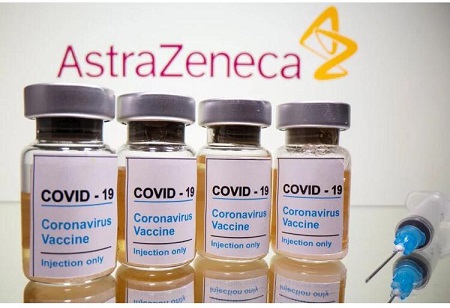COVID-19 Vaccine AstraZeneca significantly boosted antibody levels against Omicron

University of Oxford study supports use of COVID-19 Vaccine AstraZeneca as third dose booster against Omicron
Neutralising antibody levels against Omicron following a third dose boost of COVID-19 Vaccine AstraZeneca were broadly similar to levels achieved after two doses against the Delta variant.
AstraZeneca’s Vaxzevria (ChAdOx1-S [Recombinant]) significantly boosted levels of antibodies against the Omicron SARS-CoV-2 variant (B.1.1.529) following a third dose booster, according to data from a new laboratory study.1
Neutralisation titres for Omicron were boosted following a third dose with Vaxzevria compared to titres after a second dose.1
The levels seen after the third dose booster were higher than the neutralising antibodies found in individuals who had been previously infected with and recovered naturally from COVID-19 (Alpha, Beta, Delta variants and original strain).1
Sera obtained from individuals one month after receiving the third dose booster vaccination neutralised the Omicron variant to levels that were broadly similar to those observed one month after the second dose against the Delta variant.1 Two doses of Vaxzevria have been associated with protection against the Delta variant in real world studies.2,3
The study analysed blood samples taken from individuals infected with COVID-19; those who had been vaccinated with a two-dose schedule and a third dose booster; and those who had reported previous infection from other COVID-19 variants of concern. The study included samples from 41 individuals who had received three doses of Vaxzevria.1
The study was performed independently by investigators at the University of Oxford and the findings were posted online on the bioRxiv pre print server.
Professor Sir John Bell, Regius Professor of Medicine, University of Oxford, UK and one of the study investigators, said: “It is very encouraging to see that current vaccines have the potential to protect against Omicron following a third dose booster.
These results support the use of third dose boosters as part of national vaccine strategies, especially to limit the spread of variants of concern, including Omicron.”
Sir Mene Pangalos, Executive Vice President, BioPharmaceuticals R&D, AstraZeneca said: “Vaxzevria plays an important role in vaccination programmes around the world and these data give us confidence that the vaccine should be given as a third dose booster.
It is also important to look beyond antibodies to better understand how vaccines offer protection against Omicron. As we better understand Omicron, we believe we will find that T-cell response provides durable protection against severe disease and hospitalisations.”
Data from another laboratory study support Vaxzevria’s effect against Omicron, with individuals vaccinated with two doses of Vaxzevria retaining neutralising activity against Omicron, although a decrease was seen compared to the original strain.4 In other studies, Vaxzevria has been shown to generate a diverse and durable T-cell response to multiple variants resulting in a broader response than antibodies alone, which could contribute to protection against COVID-19.1,5-9
AstraZeneca is collecting real world evidence evaluating the effectiveness against the Omicron variant with academic groups in the southern African region.
AstraZeneca is also analysing blood samples from participants in the Company’s Phase II/III trial to evaluate neutralising activity when given as a third dose booster against Omicron for both Vaxzevria and its investigational next generation COVID-19 vaccine, AZD2816. Data from these studies are expected soon.
Currently available data against variants of concern, excluding Omicron, support the use of a third booster with Vaxzevria as part of a homologous or heterologous schedule.6,10
A sub analysis from the COV001 and COV002 trials demonstrated that a third dose of Vaxzevria given at least six months after a second dose boosted antibody levels six-fold and maintained T cell response.6 A third dose also resulted in higher neutralising activity against the Alpha, Beta, and Delta variants, compared with a two-dose regimen. In the trial, the third dose of Vaxzevria was less reactogenic than the first dose.6
In addition, the COV-BOOST trial showed that a third dose booster of Vaxzevria induced significantly higher immune responses compared with controls against the Delta variant and original strain following a primary vaccine series of Vaxzevria or Pfizer BioNtech (BNT162b2).10
The University of Oxford study
The University of Oxford laboratory study assessed the neutralisation of Omicron by a large panel of sera collected from convalescent early pandemic, Alpha, Beta, Gamma and Delta infected individuals, as well as from individuals that had received three doses of Vaxzevria or the Pfizer BioNtech (BNT162b2) vaccines.
In total, samples were analysed from 41 individuals that had received three doses of Vaxzevria, and 20 individuals that had received three doses of Pfizer BioNtech (BNT162b2) vaccine.1
Vaxzevria
Vaxzevria (ChAdOx1-S [Recombinant], formerly AZD1222) was co-invented by the University of Oxford and its spin-out company, Vaccitech. It uses a replication-deficient chimpanzee viral vector based on a weakened version of a common cold virus (adenovirus) that causes infections in chimpanzees and contains the genetic material of the SARS-CoV-2 virus spike protein. After vaccination, the surface spike protein is produced, priming the immune system to attack the SARS-CoV-2 virus if it later infects the body.
The vaccine has been granted a conditional marketing authorisation or emergency use in more than 90 countries. It also has Emergency Use Listing from the World Health Organization, which accelerates the pathway to access in up to 142 countries through the COVAX Facility.
Under a sub-license agreement with AstraZeneca, the vaccine is manufactured and supplied by the Serum Institute of India under the name COVISHIELD.
AstraZeneca
AstraZeneca (LSE/STO/Nasdaq: AZN) is a global, science-led biopharmaceutical company that focuses on the discovery, development, and commercialisation of prescription medicines in Oncology, Rare Diseases, and BioPharmaceuticals, including Cardiovascular, Renal & Metabolism, and Respiratory & Immunology. Based in Cambridge, UK, AstraZeneca operates in over 100 countries and its innovative medicines are used by millions of patients worldwide. Please visit astrazeneca.com and follow the Company on Twitter @AstraZeneca.
References
1. Dejnirattisai W. et al. Omicron-B.1.1.529 leads to widespread escape from neutralizing antibody responses. BioRxiv. Available at: https://www.biorxiv.org/content/10.1101/2021.12.03.471045v2.full.pdf Last accessed December 2021.
2. Public Health England. Effectiveness of COVID-19 vaccines against hospital admission with the Delta (B.1.617.2) variant. Available at: https://khub.net/web/phe-national/public-library/-/document_library/v2WsRK3ZlEig/view_file/479607329?_com_liferay_document_library_web_portlet_DLPortlet_INSTANCE_v2WsRK3ZlEig_redirect=https%3A%2F%2Fkhub.net%3A443%2Fweb%2Fphe-national%2Fpublic-library%2F-%2Fdocument_library%2Fv2WsRK3ZlEig%2Fview%2F479607266 Last accessed December 2021.
3. Sheikh A. et al. SARS-CoV-2 Delta VOC in Scotland: demographics, risk of hospital admission, and vaccine effectiveness. The Lancet. Available at: https://www.thelancet.com/journals/lancet/article/PIIS0140-6736(21)01358-1/fulltext#articleInformation Last accessed December 2021.
4. Cameroni E et al. Broadly neutralizing antibodies overcome SARS-CoV-2 Omicron antigenic shift. BioRxiv. Available at: https://doi.org/10.1101/2021.12.12.472269 Last accessed December 2021
5. Swanson P. et al. T-cell mediated immunity after AZD1222 vaccination: A polyfunctional spike-specific Th1 response with a diverse TCR repertoire. Science Translational Medicine. Available at: https://www.science.org/doi/10.1126/scitranslmed.abj7211 Last accessed December 2021.
6. Flaxman A. Tolerability and immunogenicity after a late second dose or a third dose of ChAdOx1 nCoV-19 (AZD1222). The Lancet. Available at: https://papers.ssrn.com/sol3/papers.cfm?abstract_id=3873839. Last accessed December 2021.
7. Redd, A. D. et al. Minimal cross-over between mutations associated with Omicron variant of SARS-CoV-2 and CD8+ T cell epitopes identified in COVID-19 convalescent individuals. BioRxiv. Available at: https://www.biorxiv.org/content/10.1101/2021.12.06.471446v1 Last accessed December 2021.
8. Parry H et al. Single Vaccination with BNT162b2 or ChAdOx1 in Older People Induces Equivalent Antibody Generation but Enhanced Cellular Responses after ChAdOx1. The Lancet. Available at: https://ssrn.com/abstract=3825573 Last accessed December 2021.
9. Parry H et al. Differential immunogenicity of BNT162b2 or ChAdOx1 vaccines after extended-interval homologous dual vaccination in older people. Immun Ageing. 2021; 18,34. Available at: https://doi.org/10.1186/s12979-021-00246-9 Last accessed December 2021.
10. Munro A PS et al. Safety and immunogenicity of seven COVID-19 vaccines as a third dose (booster) following two doses of ChAdOx1 nCov-19 or BNT162b2 in the UK (COV-BOOST): a blinded, multicentre, randomised, controlled, phase 2 trial. The Lancet. Available at: https://doi.org/10.1016/S0140-6736(21)02717-3 Last accessed December 2021.




